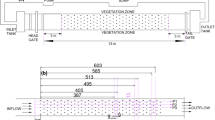Abstract
Spillway tunnels are a key structure in large-scale water conservancies. The high-head water inlet makes the water surface-velocity extremely high, and the air is driven by the free surface of the water to move downstream. This paper studies the air velocity distribution above the water surface through the model tests, under the assumption that the airflow is a turbulent boundary layer with a rough interface, and the influence of the water depth and the water velocity on the air velocity distribution is analyzed. It is shown that the air velocity is in an exponential distribution. As the measured position moves upward, the air velocity gradually decreases, and the gradient decreases. When the water depth increases, the air velocity increases but with the same distribution form. With the increase of the water surface-velocity, the air velocity at the same measuring point increases, the variation range near the water surface is large, the air boundary layer height increases slightly, and the index coefficient of the air velocity distribution function decreases. Through numerical fitting, the calculation formula of the air boundary layer thickness at different water surface velocities is obtained, along with the numerical value of the index coefficient.
Similar content being viewed by others
References
Novak P., Moffat A., Nalluri C. et al. Hydraulic structures [M]. New York, USA: Taylor and Francis, 2006.
Chanson H. Air-water flows in water engineering and hydraulic structures. Basic processes and metrology [C]. Proceedings of the International Conference on Hydraulics of Dams and River Structures, Tehran, Iran, 2004.
Shi Q. S. High-speed water-air two-phase flow [M]. Beijing, China: China Water Resources and Hydropower Press, 2007(in Chinese).
Wu C. G. Two-phase flow of water and gas in an open channel [M]. Chengdu, China: Chengdu University of Science and Technology Press, 1989(in Chinese).
Yalin M. S. Theory of hydraulic models [M]. London, UK: Macmillan, 1971.
Bombardelli F. A., Meireles I., Matos J. Laboratory measurements and multi-block numerical simulations of the mean flow and turbulence in the non-aerated skimming flow region of steep stepped spillways [J]. Environmental Fluid Mechanics, 2011, 11(3): 263–288.
Ma J., Oberai A. A., Drew D. A. et al. A comprehensive sub-grid air entrainment model for RaNS modeling of free-surface bubbly flows [J]. The Journal of Computational Multiphase Flows, 2011, 3(1): 41–56.
Meireles I. C., Bombardelli F. A., Matos J. Air entrainment onset in skimming flows on steep stepped spillways: an analysis [J]. Journal of Hydraulic Research, 2014, 52(3): 375–385.
Valero D., García-Bartual R. Calibration of an air entrainment model for CFD spillway applications [M]. Singapore: Springer, 2016.
Wei W., Deng J., Xu W. Numerical investigation of air demand by the free surface tunnel flows [J]. Journal of Hydraulic Research, 2020, 59(1): 185–165.
Ervine D., Falvey H. Behaviour of turbulent water jets in the atmosphere and in plunge pools [J]. Ice Proceedings, 2015, 83(1): 295–314.
Straub L. G., Anderson A. G. Experiments on self-aerated flow in open channels [J]. American Society of Civil Engineers, 1958, 84(7): 1–35.
Killen J. M. The surface characteristics of self-aerated flow in steep channels [D]. Doctoral Thesis, Minneapolis, USA: University of Minnesota, 1968.
Wilhelms S. C., Gulliver J. S. Bubbles and waves description of self-aerated spillway flow [J]. Journal of Hydraulic Research, 2005, 43(5): 522–531.
Falvey H. T. Air-water flow in hydraulic structures [R]. Denver, CO, USA: United States Bureau of Reclamation Engineering Monograph, No. 41, 1980.
Valero D., Bung D. B. Development of the interfacial air layer in the non-aerated region of high-velocity spillway flows. Instabilities growth, entrapped air and influence on the self-aeration onset [J]. International Journal of Multiphase Flow, 2016, 84: 66–74.
Chanson H. Turbulent air-water flows in hydraulic structures: Dynamic similarity and scale effects [J]. Environmental Fluid Mechanics, 2009, 9(2): 125–142.
Ishii M., Hibiki T. Thermo-fluid dynamics of two-phase flow [M]. New York, USA: Springer Science and Business Media, 2011.
Chanson H. Hydraulics of aerated flows: Qui pro quo? [J]. Journal of Hydraulic Research, 2013, 51(3): 223–243.
Chanson H. Turbulent air-water flows in hydraulic structures: Dynamic similarity and scale effects [J]. Environmental Fluid Mechanics, 2009, 9(2): 125–142.
Heller V. Scale effects in physical hydraulic engineering models [J]. Journal of Hydraulic Research, 2011, 49(3): 293–306.
Jiang F., Xu W., Deng J. et al. Flow structures of the air-water layer in the free surface region of high-speed open channel flows [J]. Mathematical Problems in Engineering, 2020, 7(1): 5903763.
Acknowledgement
This work was supported by the Sichuan Science and Technology Program (Grant No. 2020YJ0320).
Author information
Authors and Affiliations
Corresponding author
Additional information
Project supported by the National Natural Science Foundation of China (Grant No. 51939007).
Biography
Jing Gong (1996-), Male, Ph. D. Candidate
Rights and permissions
About this article
Cite this article
Gong, J., Deng, J., Wei, Wr. et al. Characteristics of air flow driven by the free surface of the open channel. J Hydrodyn 34, 69–75 (2022). https://doi.org/10.1007/s42241-022-0007-6
Received:
Revised:
Accepted:
Published:
Issue Date:
DOI: https://doi.org/10.1007/s42241-022-0007-6




